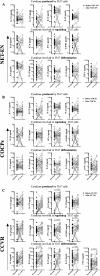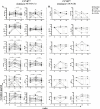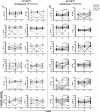Impact of Hormonal Contraceptives on Cervical T-helper 17 Phenotype and Function in Adolescents: Results from a Randomized, Crossover Study Comparing Long-acting Injectable Norethisterone Oenanthate (NET-EN), Combined Oral Contraceptive Pills, and Combined Contraceptive Vaginal Rings
- PMID: 31675420
- PMCID: PMC7755094
- DOI: 10.1093/cid/ciz1063
Impact of Hormonal Contraceptives on Cervical T-helper 17 Phenotype and Function in Adolescents: Results from a Randomized, Crossover Study Comparing Long-acting Injectable Norethisterone Oenanthate (NET-EN), Combined Oral Contraceptive Pills, and Combined Contraceptive Vaginal Rings
Abstract
Background: Adolescents in sub-Saharan Africa are at risk for human immunodeficiency virus (HIV) infection and unintended pregnancies. Observational studies suggest that injectable hormonal contraceptives (HCs) increase the HIV risk, although their effects on genital inflammation, particularly HIV-susceptible T-helper 17 (Th17) cells, are unknown. In a randomized crossover study, the effect of injectable norethisterone oenanthate (NET-EN), combined contraceptive vaginal rings (CCVR; NuvaRing), and combined oral contraceptive pills (COCPs) on cervical Th17 cells and cytokines were compared.
Methods: Adolescents (n = 130; 15-19 years) were randomly assigned 1:1:1 to NET-EN, CCVR, or COCPs for 16 weeks, then subsequently crossed over to another HC for 16 weeks. Estrogen, follicular stimulating hormone (FSH), and luteinizing hormone (LH) levels were measured. Chemokine receptor 5 (CCR5), human leukocyte antigen (HLA) DR isotope, and cluster of differentiation 38 (CD38) expression by cervical cytobrush-derived CD4+ T cells was assessed by fluorescence-activated cell sorting. Th17 cells were defined as CCR6+ and CCR10-. Cervicovaginal Th17-related cytokines were measured by Luminex.
Results: CCVR use for the first 16 weeks was associated with reduced Th17 frequencies and lower FSH and LH concentrations, as compared to NET-EN and COCPs, with FSH concentrations and Th17 frequencies correlating significantly. However, Th17-related cytokine concentrations (interleukin [IL]-21, IL-1β, tumor necrosis factor-α, interferon-γ) and CCR5, HLA-DR, CD38, and Th17 frequencies were significantly higher in CCVR than NET-EN and COCP. At crossover, CCVR users changing to COCPs or NET-EN did not resolve activation or cytokines, although switching from COCP to CCVRs increased cytokine concentrations.
Conclusions: CCVR use altered endogenous hormone levels and associated cervical Th17 cell frequencies to a greater extent than use of NET-EN or COCPs, although Th17 cells were more activated and Th17-related cytokine concentrations were elevated. While CCVRs may impact the HIV risk by regulating Th17 numbers, increased activation and inflammation may balance any risk gains.
Keywords: CCVR; FSH; NET-EN; Th17; cytokines.
© The Author(s) 2019. Published by Oxford University Press for the Infectious Diseases Society of America.
Figures







References
-
- Joint United Nations Programme on HIV and AIDS (UNAIDS). Ending AIDS progress towards the 90-90-90 targets. Glob Aids Updat 2017; 24–26. Available at: http://www.unaids.org/sites/default/files/media_asset/Global_AIDS_update.... Accessed 25 September 2019.
-
- Evidence for Contraceptive Options and HIV Outcomes (ECHO) Trial Consortium. HIV incidence among women using intramuscular depot medroxyprogesterone acetate, a copper intrauterine device, or a levonorgestrel implant for contraception: a randomised, multicentre, open-label trial. Lancet 2019; 394:303–13. - PMC - PubMed
Publication types
MeSH terms
Substances
Grants and funding
LinkOut - more resources
Full Text Sources
Research Materials

